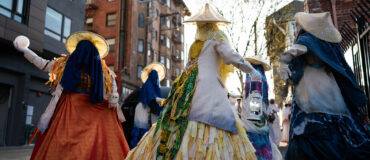Dance/USA Honoree Jawole Willa Jo Zollar: Liberating the Pelvis … and the Dance Field

Crush Boone, courtesy Urban Bush Women
By Lisa Traiger
In founding Urban Bush Women in 1984, dancer/choreographer/educator Jawole Willa Jo Zollar laid the underpinnings for a company and a process of working that draws on her interest in and commitment to the culture of African Americans and the African Diaspora, utilizing folklore, religious and cultural traditions that merge and influence contemporary dance and performance. This month she receives Dance/USA’s Honor Award for her extraordinary leadership in the field through both artistic excellence and force of vision.
Born in Kansas City, Zollar grew up in the era of segregation, but the arts — dance, music (her mother Dorothy had been a jazz singer), art — were an integral part of her upbringing. As was church. The family with all six kids attended Allen Chapel AME Church every Sunday. Although her parents were particularly religious, they understood the importance of the community the local black church provided. That sense of community, of neighbors who looked out for one another and would call the parents about a misbehaving child, became something Zollar sought to recreate in the dance company she founded.

Susan Hamburger, courtesy Urban Bush Women
Today, after more than three decades, art-making and community-building are nearly one-and-the-same in Zollar’s work with Urban Bush Women in New York, at the company’s annual Summer Leadership Institute (SLI), and in residencies and touring stops around the country, and with her latest project: Urban Bush Women Choreographic Center. “Well, [my work has] always been more than dance and that’s not to diminish dance,” she said. “I had a theater background in college. I came up in a family that had a strong interest in jazz and those were two influences in terms of my vision. Essentially I am a product of the Black Arts movement.”
Following early training in Dunham technique, Afro-Cuban and other Africanist dance forms, Zollar received her undergraduate degree in dance from University of Missouri at Kansas City and earned an MFA at Florida State University, where she is presently a dance professor. A move to New York in 1980 took her to renowned dancer, choreographer and teacher Dianne McIntyre, with whom she worked (although never in McIntyre’s company) for four years.
On creating Urban Bush Women, Zollar said: “I just started to feel I have something more to say …” The name was inspired by “Harlem Bush Music,” an album by jazz saxophonist Gary Bartz. “I didn’t want a name that was attached only to me as a choreographer,” she said. “I wanted a name that had to do with the conceptual framework I wanted to create. I wanted the feel of an ensemble …. And the first time I heard that album, I was intrigued by the concept.” She added that growing up in what was considered the inner city, she liked the idea of looking at that built environment as bush: “It’s thick. It’s dense. It’s creative. It’s fertile. There’s danger. I liked all that. So we became Urban Bush Women.” The fact that I grew up in what people called the inner city and the idea of looking at that environment as a kind of bush — it’s thick, it’s dense, it’s creative, it’s fertile, there’s danger. That to me was very intriguing.”
The Whole Body Is a Part of Creative Expression
It has been said that Zollar liberated the pelvis. She quietly demurs, noting Martha Graham’s iconic use of the pelvis in her early modern dance technique. But really, the choreographer pointed out, the pelvis has been a part of dances the world over for millennia. It had been Western forms that were averse to this central part of a dancer’s — a human’s — anatomy being emphasized through movement.
Zollar noted, “The whole body is a part of creative expression. And in certain forms, the pelvis area was diminished in terms of having movement.” Her 1995 “Batty Moves” was initially viewed as subversive in that it boldly showcased women of color and of varying shapes and sizes unapologetically reveling in showing off and shaking their butts. Batty is a Caribbean term for the behind and the dance embraces that body part using African, Afro-Caribbean, reggae, and other dance forms and styles. It’s fun and pointedly liberating, and became one of the company’s signature works for a time. “We embrace that liberation … The movement of the pelvis is just a very natural thing. It’s not questioned. That for me is an important part of how we approach the body and how we approach movement.”
The company began touring soon after its founding and Zollar and the dancers noticed that audiences were rarely diverse, even in a city like Charleston, S.C., during the Spoleto Festival. “Charleston is a city with a very large black population,” Zollar said, “but we didn’t see them in the audience. It’s not that [African American] audiences didn’t want to come, the venues, particularly in Charleston at that time, still carried associations with the way segregation played out. We realized that just putting a black face on a poster was not necessarily going to bring black people into the theater. We started looking at how to change that.”
Zollar with input from the company dancers at that time re-thought how UBW worked, its process, its output, and came up with a far more community-based way to both reach audiences in places where they’re comfortable and re-shape the company’s own choreographic methodology and product. “We went into community centers, to black churches, to places in the black community and made connections … by talking with them and doing workshops. It was a very conscious: We were looking for people we thought would be important to have in the audience in terms of how they would relate to our work.”
Today, what began as a way to reach and engage with core audiences across both the racial and economic spectrum, has evolved into a full-fledged training program in facilitation and leadership that centers on dance, but involves a diversity of other art and cultural forms, social and civic engagement processes and more. The majority of attendees are typically not dancers or choreographers, although movement and dance remain an integral part of UBW’s annual Summer Leadership Institute.
“What we do is multifaceted,” Zollar explained. “There are different ways of engagement, from embodied practice, to dialogue, to being in circles, to how people experience a situation. It’s not just teaching per se. It’s an experience, completely experiential. We’re not the teachers in the room; we are the practitioners. We are engaging with other practitioners of many different levels of experience. Some in our leadership institute have been doing this for 20, 30, 40 years and some have just graduated from high school and are on the very beginning of the journey. We don’t have one population or one way we engage. We work with theater games, we work with builders, there’s a multitude of platforms by which we look at how we craft our practice.”
The honing of the structure and practices in the SLI has dramatically changed the way Zollar and the dancers collaborate in the studio during the choreographic process. “For us it’s all making work. There’s not a separation. It’s all a creative practice,” she said. “When we’re in the studios, yes, it’s all professionals. These are people who have dedicated their lives to dance. When we’re working in community, where there are people for whom dance is not their practice, we still see it all as part of our creed and practice.” That means that what happens in a community setting may not differ drastically from what happens when only the professional are in the room. What does differ, Zollar noted, is the intensity. The annual SLI lasts for 10 days; a creative choreographic project may be a three-year process.
Supporting Women Choreographers of Color
Zollar’s latest project is the development the Urban Bush Women Choreographic Center, which is meant to support individual women choreographers of color and also push for systemic change in the field to broaden opportunities for all.
The impetus came from the realization after “Fly: Five First Ladies of Dance,” a performance program that brought together legacy African American female choreographers — including Zollar, Dianne McIntyre, Germaine Acogny, Carmen de Lavallade and Bebe Miller — that not enough next-generation women of color choreographers were gaining prominence. “I thought, why is that? Then I started to think about how can we strengthen that presence,” Zollar said. While the center is in its developmental stage, she said, “We want to influence the field and change the mechanisms and the ways people see experimental choreography coming out of communities of women of color and we want to strengthen the work and support the work of women of color choreographers.” That means creating support structures and funding for residencies, and providing education opportunities for learning dramaturgy and research practices to enhance young choreographers as they develop. “We can reduce it to the supply-and-demand side …. We’re going to experiment with this for a few years and find the best ways to work and models to employ.”
Zollar is a true collaborator in the studio and beyond — but she’s careful about who she works with. “What I’ve learned about collaboration is that there has to be chemistry between you and the collaborators,” she said. “There can be tension, but it has to be creative tension. I build relationships slowly to ensure a good kind of collaboration.” One of her longstanding collaborators has been fellow choreographer Liz Lerman. Their shared interest in working outside the studio in communities with non-traditional participants has made them kindred spirits, soul sisters of dance. Lerman, a previous Dance/USA Honor awardee, wrote about her colleague: “Jawole is a true visionary. She lived things and experienced things and saw things and then, despite all the structures and presumptions about how a dance artist should make work, she went about doing it in a totally different way. She reclaimed her own past and made us all see that differently … and that is no small thing when you look around and see how history bedevils us today…. She developed language that helps us understand so much about being an artist and a woman and a person of color … and somehow managed to do all of this, and more, with great humor, some deserved anger, but not bitterness.”
Lisa Traiger edits From the Green Room, Dance/USA’s online journal, and writes frequently on dance and the performing arts for a variety of publications including Dance, Dance Teacher and Washington Jewish Week.
____
We accept submissions on topics relevant to the field: advocacy, artistic issues, arts policy, community building, development, employment, engagement, touring, and other topics that deal with the business of dance. We cannot publish criticism, single-company season announcements, and single-company or single artist profiles. Additionally, we welcome feedback on articles. If you have a topic that you would like to see addressed or feedback, please contact communications@danceusa.org.
Disclaimer: Opinions expressed in guest posts do not necessarily represent the viewpoints of Dance/USA.




